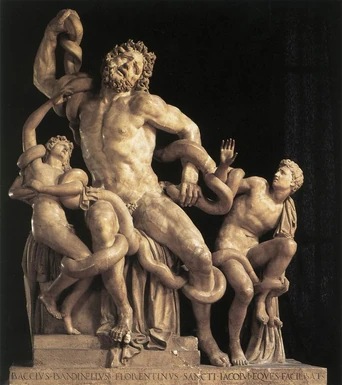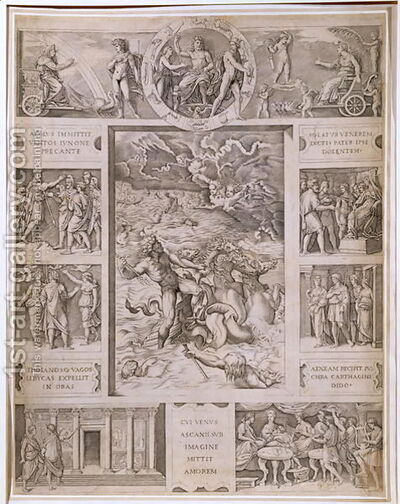
Laocoon and his sons being attacked by twin snakes
Introduction by Katie Smith[]
The techniques described in this article (and report) represent Vergil’s attempt to continuously thread a word or idea throughout the storyline. I enjoyed this article because it is interesting to read a different interpretation of one of my favorite scenes in the Aeneid. Jameson pointed out Bernard Knox’s argument that Vergil uses the repetition of images of “fire” and the “serpent”. These repeated themes are symbolized through the actual use of words like “flammae” or “serpens”; and also through juxtaposed representations (like the Greeks, Trojan horse, etc.). This imagery can be found not only in the death of Laocoon, but also in various parts of the Aeneid. Other techniques that Knox used was analyzing the cultural meanings of these images, and understanding other author’s interpretations of Vergil’s work.
After reading the other reports, it is obvious that the technique of using repetition is common. For example, in Meshach’s article, the author counted the frequent use of the theme of sadness, and the word “maestus”. Other reports showed similar patterns: Christian’s article followed the use of “father”, and even my report talked about how epic poetry uses the same recurring themes of violence, divine intervention, etc. I think that the strength of using this technique is that it helps get an important message across to the audience. For instance, in this particular report about Laocoon, Vergil continues to use the theme of serpents and fire to represent the treachery and betrayal of the Greeks. Although this technique does instill these messages into our heads, I think it may detract from their overall meaning. Vergil has a very unique style of writing, which is not only beautiful to read, but also historical. We have to remember that the Aeneid, along with being an epic story, is also a propaganda war poem written for Augustus. I think that Vergil is using all of these symbols to represent the fall of Troy, the struggles of Aeneas, and the eventual rebirth into the foundation of Rome. Yes, the technique of repetition is helpful to highlight important concepts, but I think it may distract the reader from its true meaning. From reading all of these critical reports, it is great to see the various interpretations of Virgilian work! Katie Smith 04:58, February 16, 2011 (UTC)
The Serpent and the Flame by B.M.W. Knox[]
Part I: Knox's Argument[]
In his article, The Serpent and the Flame, B.M.W. Knox explains the significance of Virgil's repeated use of imagery related to snakes and fire in book two of the Aeneid. Knox explains that for the Trojans, the Greeks are both snakes and fire, and as such they employ the use of deceit and destruction. The most profound example of this that Knox brings to light is the incident where Laocoon's sacrificial rites are interrupted by a pair of twin sea snakes. This pair of snakes originated from Tenedos, the nearby island where the Graecian fleet is hiding. In describing the snakes passage across the water, Vergil says that their bloody spines emerge from the waves (iubaeque sanguineae superant undas line 207), which is a similar visual image to the sails of the approaching Graecian fleet as well as the flames that overcome the city of Troy itself (Volcano superante domus line 311 and exsuperant flammae line 759). Furthermore, these snakes are described as having fiery eyes, clearly something more than just a physical characteristic; they seek out destruction. Another convincing example of this repeated snake imagery is the manner in which Vergil describes the movement of the Trojan horse. The phrase rotarum lapsus (line 235) is used to describe how the horse was moved into the city- the gliding of its' wheels. In book 2 of the Aeneid, Knox asserts that the repeated use of snake imagery is an extended metaphor for the whole situation surrounding the fall of Troy. The snakes represent secrecy and deceit, the resulting in fear among the Trojans, and traitorous characters like Sinon (whose name is derived from sinus, a bend or curve).
Part II: Knox's Analytical Technique[]
In his analysis of the role of serpents and flames in book two, Knox employs a number of different techniques. Chief among these techniques is the interpretation of certain words in other Latin texts, mainly by those who inspired Vergil or who were inspired by him. While describing the use of the word repere (to creep or crawl, derived from the greek έρπω), Knox cites surrepens from Catullus, obrepens from Ovid and subrepsit from Statius. Using these comparisons, Knox concludes that “These instances, from one of Virgil's predecessors, a contemporary and one of his successors, show that Vergil, as so often, is varying a stock expression, and the variant he employs calls attention to the dominant metaphor”. At the bottom of every page, we find footnotes that abound with references to certain words of significance being used in similar or dissimilar ways in the texts of other classical authors.
Knox's analysis also relies on cultural perceptions of snakes, both from modern times and from the past. He makes the important realization that snakes are a very powerful symbol in any society, and that words derived from the activities of snakes are commonly applied to other things, like hissing, wriggling and flickering tongues. In Latin, we commonly find certain words that Knox says intrinsically relate to snakes for the ancient Roman: serpere (to creep or crawl), lambere (to lick or lap) and micare (to move in a quivering manner). Knox also makes the important note that the symbolism of the serpent is ambiguous in cultures. The snake causes destruction and fear, nevertheless, it also represents regrowth when it sheds its skin each spring.
The final technique that Knox employs in his study is consulting other classicists' analysis of Vergil's work. For example, he cites the work of Henry, who puts forth the claim that the dual nature of serpents that attack Laocoon and his sons is meaningful. He takes the quote “The twin serpents prefigure the Graecian armament, which, like them, come from Tenedos... like them crosses the tranquil deep... lands... slaughters the surprised and unsuspecting Trojans (prefigured by Laocoon's sons) and overturns the religion and drives out the god (prefigured by Laocoon)”. By using and citing the work of other classical scholars, Knox legitimizes his research and also creates a network of similarly aimed studies. Looking at the footnotes again, we find numerous other references to other classicists work, which serve to verify the information he is presenting, but more importantly give the reader the ability to seek out these articles and learn more about the Aeneid.
Part III: Book I- Chaos at Sea[]

Storm scene from book one of the Aeneid
Applying Knox's technique of seeking deeper meaning in vocabulary can be applied to other sections of the Aeneid as well. In book one, we are introduced to the story and presented with the conflict that will drive the plot- Juno's desire to prevent Aeneas from continuing the Trojan line. In this book we find numerous examples of verbs relating to erratic or even destructive motion, conveying a sense of chaos in the world. In this book of the Aeneid, the use of these words is very profound; Aeneas' world has been destroyed, his religion overturned, and now his last chance of escape was almost thwarted by the tempestuous powers of Aeolus and the winds he commands. Words like volvere, verrare, and ruere are significant as they are meant to show the chaotic and dangerous situation that Aeneas has found himself in.
One such word that we see numerous times is Volvo, to roll or turn about. This word is used to describe physical action, as in the case of Aeolus' storm causing huge waves to turn towards the shore (et vastos volvunt ad litora fluctus line 86). However, this word is also used to describe a change in fortune, when the race that had been so nearly destroyed was now destined by fate to annihilate Juno's African kingdom (sic volvere Parcas line 22). Numerous examples of the the use of volvo crop up in book one, on line 101 to describe how men and weaponry are dragged into the ocean, and towards the end of book one, Dido says that she too was rolled about by fates and tempests, but this change in fortune led her to establishing a new city (iactatam hac demum voluit consistere terra line 629). This word has a special significance to the Aeneid; it represents the duality of chaos. With chaotic occurrences, come death and destruction, as well as opportunities for glory and a new beginning.
Another important word Vergil employs in the first book of the Aeneid is ruere, to fall by violence, or go to ruin. This is obviously another word with significant meaning to this story. The fall of troy was instigated by violence, trickery and fire, and leads to chaos for the surviving Trojans. From this chaos, Aeneas leads them to fulfill a cyclic prophecy, the establishment of a new race in Latium, and the eventual vindictive destruction of Carthage. Ruere first appears on line 35, with the Trojans sailing away from Troy, and the prows of the ships cutting through the water (spumas salis aere ruebant). As soon as 40 lines into the book, the Trojans are already recovering and beginning their own path of destruction. In the end, this sort of chaos is inevitable in all cultures. Like an organism entering a new environment, first there will be sickness and weariness, but they will adapt and ultimately become stronger.